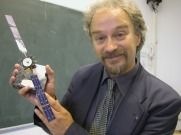Preparations for lunar collision

Professor Manuel Grande with a 1/40 scale model of Smart-1
23 August 2006
Smart-1's scientific instruments have subjected the Moon to new scrutiny and worked so well that the mission was extended by an additional year. The UK instrument D-CIXS (a demonstrator compact X-ray spectrometer) has obtained mineral maps of the Moon’s composition, looking at the distribution of calcium, magnesium, aluminium, silicon and iron. These will help to determine if the Moon was formed from terrestrial debris after a collision or mostly from a planet-sized object that crashed into the Earth.
The Principal Investigator on the D-CIXS is Professor Manuel Grande, Head of Solar System Physics at the Institute of Mathematical and Physical Sciences at the University of Wales, Aberystwyth.
“By measuring the X-rays emitted when the Sun shines on the Moon, we can analyse the chemical composition of the surface. We then compare the abundances of key minerals to those found on the Earth to understand how much of the Moon’s material came from our planet originally.”
D-CIXS plays an important role in understanding the Moon and gives us new insight into whether the samples brought back from manned missions are typical of the lunar surface or not. Manuel Grande said “Where we can make comparisons with American landing sites, the agreement is good, which gives us confidence when we look at the data from areas of the Moon that have not been visited by humans.”.
D-CIXS has proved so successful that an enhanced version (called CIXS) is now under construction to fly on the Indian Chandrayaan mission to the Moon in 2007/8.
Professor Grande will be holding a session for the press at the University of Wales, Aberystwyth on Friday 25 August. The session takes place at the Institute of Mathematical and Physical Sciences building and will start at 10.00 a.m. Professor Grande will be joined by Dr Vera Fernandez from Coimbra, Portugal, who is also working on the project.



